INSTITUT SUPERIEUR D'ANTHROPOLOGIE
INSTITUTE OF ANTHROPOLOGY
ONLINE COURSES / COURS A DISTANCE
FALL TERM : OCTOBER 2015
REGISTER NOW
USA - 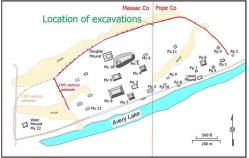
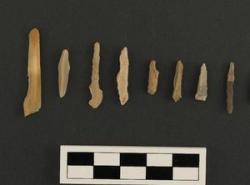 x Kincaid Mounds - In a bedroom-size section of land at Kincaid, seven undergraduate archaeology students, two graduate assistants and Welch unearthed quite a few artifacts, stones believed to be used in jewelry and jewelry-making tools. The Kincaid Mounds are located near the Massac-Pope county line, in a mile-long oblong-shaped area of fields divided by stretches of wood and bordered on the south by Avery Lake. There are five mounds that are recognizable as mounds, ranging from about six feet to 30 feet high. Welch said there are 22 more mounds, most appearing as gentler rises and slopes in the land. The Mounds are known by scientific designations: From the observation deck, they are Beehive (Mx7), the third tallest; Mx8, which once housed the Kincaid family home and is the second highest; the next one, known as Barn Mound, because it housed the Kincaid family's barn; the tallest one, called the Conical Offset Mound because of its shape; and the smallest one, simply known as Mx4. The mounds are almost encased by a line of trees; to the east of them are a line of trees that mark the Massac's boundary with Pope. Just over that thicket of trees, to the north, was the small plot of land cleared for the archaeological dig this summer, Welch said. In their midst is low, flatter land known as the plaza, space for public use. Jon Muller, Welch's predecessor at SIU, estimated 400 people once lived in the settlement; Welch puts the figure at 1,200, and believes even that is a low-ball number. Researchers refer to the Native Americans who once lived there as the Mississippian or Kincaid Indians, but Welch noted it's unknown what they called themselves. “We don’t know exactly where they went, and we don’t know where the descendants of those people are today," Welch said. "Some of them may be among the Osage in Omaha, the Quapaw of Arkansas or the Chickasaw Nation of Oklahoma." The summer's biggest find is that the structure being evacuated was likely a special-use building and not a house, based in part on the lack of pottery and food remains found. Welch and the students excavated two to three dozen pieces of fluorite, unfinished or broken scraps left over from the making fluorite beads. They also excavated 50 to 75 drills, inch to two-inch long rocks crafted to make holes in the rocks. The drills were made using a kind of flint not previously seen at the site, but similar to flint in southeast Illinois. The excavation crew also found what they believe to be a saw, made from a thin stretch of sandstone; a reamer; and files, shaped like an actual nail file. They also found evidence of a greatly deteriorated shell, perhaps a marine whelk shell that is found in Florida and also used in jewelry-making, Welch said. The group also found charcoal — remains of the burned wood — in the borders of the building and plan to send it for testing to University of Georgia Radiocarbon lab.
x Kincaid Mounds - In a bedroom-size section of land at Kincaid, seven undergraduate archaeology students, two graduate assistants and Welch unearthed quite a few artifacts, stones believed to be used in jewelry and jewelry-making tools. The Kincaid Mounds are located near the Massac-Pope county line, in a mile-long oblong-shaped area of fields divided by stretches of wood and bordered on the south by Avery Lake. There are five mounds that are recognizable as mounds, ranging from about six feet to 30 feet high. Welch said there are 22 more mounds, most appearing as gentler rises and slopes in the land. The Mounds are known by scientific designations: From the observation deck, they are Beehive (Mx7), the third tallest; Mx8, which once housed the Kincaid family home and is the second highest; the next one, known as Barn Mound, because it housed the Kincaid family's barn; the tallest one, called the Conical Offset Mound because of its shape; and the smallest one, simply known as Mx4. The mounds are almost encased by a line of trees; to the east of them are a line of trees that mark the Massac's boundary with Pope. Just over that thicket of trees, to the north, was the small plot of land cleared for the archaeological dig this summer, Welch said. In their midst is low, flatter land known as the plaza, space for public use. Jon Muller, Welch's predecessor at SIU, estimated 400 people once lived in the settlement; Welch puts the figure at 1,200, and believes even that is a low-ball number. Researchers refer to the Native Americans who once lived there as the Mississippian or Kincaid Indians, but Welch noted it's unknown what they called themselves. “We don’t know exactly where they went, and we don’t know where the descendants of those people are today," Welch said. "Some of them may be among the Osage in Omaha, the Quapaw of Arkansas or the Chickasaw Nation of Oklahoma." The summer's biggest find is that the structure being evacuated was likely a special-use building and not a house, based in part on the lack of pottery and food remains found. Welch and the students excavated two to three dozen pieces of fluorite, unfinished or broken scraps left over from the making fluorite beads. They also excavated 50 to 75 drills, inch to two-inch long rocks crafted to make holes in the rocks. The drills were made using a kind of flint not previously seen at the site, but similar to flint in southeast Illinois. The excavation crew also found what they believe to be a saw, made from a thin stretch of sandstone; a reamer; and files, shaped like an actual nail file. They also found evidence of a greatly deteriorated shell, perhaps a marine whelk shell that is found in Florida and also used in jewelry-making, Welch said. The group also found charcoal — remains of the burned wood — in the borders of the building and plan to send it for testing to University of Georgia Radiocarbon lab.
http://thesouthern.com/news/summer-archaeological-dig-work-unearths-great-finds/article_de7c84bc-63a5-51b8-939b-ce79f7ecf3af.html
ROYAUME UNI –  Cleethorpes - A prehistoric trackway that could be more than 4,000 years old has been discovered on a beach in Cleethorpes. The wooden track would have been used to cross a boggy landscape and is believed to be from the early Bronze Age, said archaeologists. It was found during a coastal survey for a project into threatened archaeological sites. About 5m of wood have been exposed by the tide. Mr Sherman said: "It is really difficult to say just how much more is preserved, it's all down to the survival quality of the wood within a peat layer." The peat's low oxygen level has protected the ancient wood from completely rotting away.
Cleethorpes - A prehistoric trackway that could be more than 4,000 years old has been discovered on a beach in Cleethorpes. The wooden track would have been used to cross a boggy landscape and is believed to be from the early Bronze Age, said archaeologists. It was found during a coastal survey for a project into threatened archaeological sites. About 5m of wood have been exposed by the tide. Mr Sherman said: "It is really difficult to say just how much more is preserved, it's all down to the survival quality of the wood within a peat layer." The peat's low oxygen level has protected the ancient wood from completely rotting away.
http://www.bbc.co.uk/news/uk-england-humber-33732116
ITALIE –  Volterra - An 80-meter-long elliptical-shaped wall discovered in the Tuscan city of Volterra could have originally been part of a Roman amphitheater, Tuscany Governor Enrico Rossi said on Friday. The recent discovery in Volterra, an important Etruscan center that became a municipium in the Roman Age, could change local archaeological history and become the most important finding of a Roman amphitheater over the last century, Rossi announced, together with Volterra Mayor Marco Buselli and Tuscany's archaeological heritage Superintendent Andrea Pessina. The wall was discovered during excavation work near the city's Porta di Diana, west of the municipal cemetery and south of the Etruscan Necropolis of Portone.
Volterra - An 80-meter-long elliptical-shaped wall discovered in the Tuscan city of Volterra could have originally been part of a Roman amphitheater, Tuscany Governor Enrico Rossi said on Friday. The recent discovery in Volterra, an important Etruscan center that became a municipium in the Roman Age, could change local archaeological history and become the most important finding of a Roman amphitheater over the last century, Rossi announced, together with Volterra Mayor Marco Buselli and Tuscany's archaeological heritage Superintendent Andrea Pessina. The wall was discovered during excavation work near the city's Porta di Diana, west of the municipal cemetery and south of the Etruscan Necropolis of Portone.
Volterra was one of the most prosperous and powerful Etruscan cities during the half-millennium before the birth of Christ and was forced to recognize the supremacy of Rome in the third century BC. One of its most well-known buildings, the Palazzo dei Priori where the town hall is located, was built in 1208 and is believed to have served as a model for Palazzo Vecchio in Florence.
http://www.ansa.it/english/news/2015/08/07/volterra-wall-discovered-possibly-from-roman-amphitheater_84847b73-c928-43f7-be9c-a03338dbcf3f.html?
BULGARIE – Hisar - A gold coin minted by Eastern Roman Emperor Arcadius (r. 395-408 AD) has been found by archaeologists from Plovdiv University “Paisiy Hilendarski” during the excavation of the Late Antiquity and medieval fortress known as Hisar near the town of Dragoynovo, Parvomay Municipality, in Southern Bulgaria. The coin has been found built into a wall in one of the building near the eastern wall of the fortress, which dates back to the Late Antiquity (4th-6th century AD). The gold coin in question was minted after the division of the Roman Empire into a Western Roman Empire with its capital in Rome, and an Eastern Roman Empire, also known today as Byzantium, with its capital in Constantinople, in 395 AD after the death of Emperor Theodosius I (r. 379-395 AD).Emperor Arcadius was the elder son of Theodosius and the brother of Emperor Honorius who ruled the Western Roman Empire from 393 until 423 AD. “The coin was minted in Constantinople as indicated by the letters written on its base,” says archaeologist Assoc.Prof. Ivan Dzhambov, who is in charge of the 8th archaeological expedition excavating the Hisar Fortress near Dragoynovo, as cited by Radio Focus Plovdiv. He adds that one side of the coin features an image of goddess Victoria Augusta sitting on a throneand holding in one hand the insignias of imperial power.
http://archaeologyinbulgaria.com/2015/08/04/archaeologists-stumble-upon-gold-coin-of-eastern-roman-emperor-arcadius-in-bulgarias-dragoynovo/
INDE – 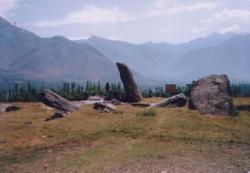 - The Archaeological Survey of India has documented 732 unprotected monuments across the country, some dating back to the Iron Age and early historical ages, during the village-to-village survey relaunched after a hiatus of over a decade. The survey, re-launched by the ASI last year, covered about 2066 villages during 2014-15. While Karnataka topped the list with 177 unprotected monuments and archaeological sites, it was followed by Tamil Nadu with 72 and Madhya Pradesh 62. According to ASI officials, during the course of the survey the authorities have documented an early historical period site in Amethi district of Uttar Pradesh dating back to the eighth century BC. The archaeological mound situated in Samaha village spreads across an area of approximately 40 acres. Similarly, in Kanarpur village of Buxar district of Bihar, the officials have surveyed an ancient site spread over 500 metres on the banks of river Ganga. The surveyors have recorded vital antiquities such terracotta human heads and parts of animal figurines. Based on the technique and shape of the pottery and antiquities, the officials observed that those might belong to the early historical period. Another significant site that was documented during the survey includes inscribed and uninscribed Sati pillars in Shivpuri district of Madhya Pradesh, the officials said. Other important finds include an Iron Age site, where 25 megalithic burials sites comprising stone circles and cairn circles were discovered.
- The Archaeological Survey of India has documented 732 unprotected monuments across the country, some dating back to the Iron Age and early historical ages, during the village-to-village survey relaunched after a hiatus of over a decade. The survey, re-launched by the ASI last year, covered about 2066 villages during 2014-15. While Karnataka topped the list with 177 unprotected monuments and archaeological sites, it was followed by Tamil Nadu with 72 and Madhya Pradesh 62. According to ASI officials, during the course of the survey the authorities have documented an early historical period site in Amethi district of Uttar Pradesh dating back to the eighth century BC. The archaeological mound situated in Samaha village spreads across an area of approximately 40 acres. Similarly, in Kanarpur village of Buxar district of Bihar, the officials have surveyed an ancient site spread over 500 metres on the banks of river Ganga. The surveyors have recorded vital antiquities such terracotta human heads and parts of animal figurines. Based on the technique and shape of the pottery and antiquities, the officials observed that those might belong to the early historical period. Another significant site that was documented during the survey includes inscribed and uninscribed Sati pillars in Shivpuri district of Madhya Pradesh, the officials said. Other important finds include an Iron Age site, where 25 megalithic burials sites comprising stone circles and cairn circles were discovered.
http://articles.economictimes.indiatimes.com/2015-08-02/news/65129442_1_senior-asi-official-monuments-archaeological-survey
GRECE – 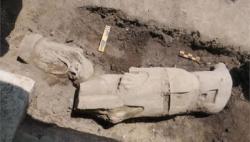
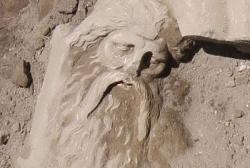 – Pella - A marble statue of Silenus, dating to the Hellenistic era, has been unearthed in the Agora of Ancient Pella. The statue was found in the North Portico of the Agora, in an area which appears to have been reserved for cult purposes. "This place constantly surprises us and has many more secrets to reveal," says the Director of the University excavations in the Agroa of Pella, I. Akamatis, who adds "this is a unique find for the area: a standing bearded male figure is depicted, wearing an animal hide and boot-like shoes, and still retaining sporadic traces of the original paint." Based on the distinctive facial features, archaeologists believe that the figure belongs to the world of Dionysus and is likely to be Silenus who, along with Satyrs and Maenads, followed the bustling god of joy and mirth. The statue was found during the excavation of the North Portico, in a destruction layer in Area 10, and has already been moved to the workshops of the archaeological site of Pella for restoration. The area where the rare find was discovered, and in general the North Portico of the Agora, does not appear to have been commercial in nature. According to Mr. Akamati, finds from the destruction layer include building foundations that, while definitely public character, suggest a more formal function, possibly reserved for worship. Near the spot where the statue was discovered, a semicircular structure with small lead pipes connected to a small water tank, probably part of a small fountain, as well as a fragment from a colossal bronze statue have also been found. The Agora is located in the centre of the archaeological site of Pella which also hosts a vast palace complex covering an area of 60,000 square metres, as well as sanctuaries, fortifications, private dwellings and a necropolis. The Hellenistic Agora, built during the reign of Cassander (late 4th century BC), is fully integrated into the urban plan of the city. Four colonnaded porticoes lined a massive open-air rectangular square whose main access point is a 15 m. wide avenue that crosses the east-west axis. The Agora served as the commercial, administrative and social center of Hellenistic Pella until its destruction 200 years later, probably by an earthquake.
– Pella - A marble statue of Silenus, dating to the Hellenistic era, has been unearthed in the Agora of Ancient Pella. The statue was found in the North Portico of the Agora, in an area which appears to have been reserved for cult purposes. "This place constantly surprises us and has many more secrets to reveal," says the Director of the University excavations in the Agroa of Pella, I. Akamatis, who adds "this is a unique find for the area: a standing bearded male figure is depicted, wearing an animal hide and boot-like shoes, and still retaining sporadic traces of the original paint." Based on the distinctive facial features, archaeologists believe that the figure belongs to the world of Dionysus and is likely to be Silenus who, along with Satyrs and Maenads, followed the bustling god of joy and mirth. The statue was found during the excavation of the North Portico, in a destruction layer in Area 10, and has already been moved to the workshops of the archaeological site of Pella for restoration. The area where the rare find was discovered, and in general the North Portico of the Agora, does not appear to have been commercial in nature. According to Mr. Akamati, finds from the destruction layer include building foundations that, while definitely public character, suggest a more formal function, possibly reserved for worship. Near the spot where the statue was discovered, a semicircular structure with small lead pipes connected to a small water tank, probably part of a small fountain, as well as a fragment from a colossal bronze statue have also been found. The Agora is located in the centre of the archaeological site of Pella which also hosts a vast palace complex covering an area of 60,000 square metres, as well as sanctuaries, fortifications, private dwellings and a necropolis. The Hellenistic Agora, built during the reign of Cassander (late 4th century BC), is fully integrated into the urban plan of the city. Four colonnaded porticoes lined a massive open-air rectangular square whose main access point is a 15 m. wide avenue that crosses the east-west axis. The Agora served as the commercial, administrative and social center of Hellenistic Pella until its destruction 200 years later, probably by an earthquake.
http://archaeologynewsnetwork.blogspot.co.uk/2015/08/marble-statue-of-silenus-unearthed-at.html#.VcTw3d-c08o